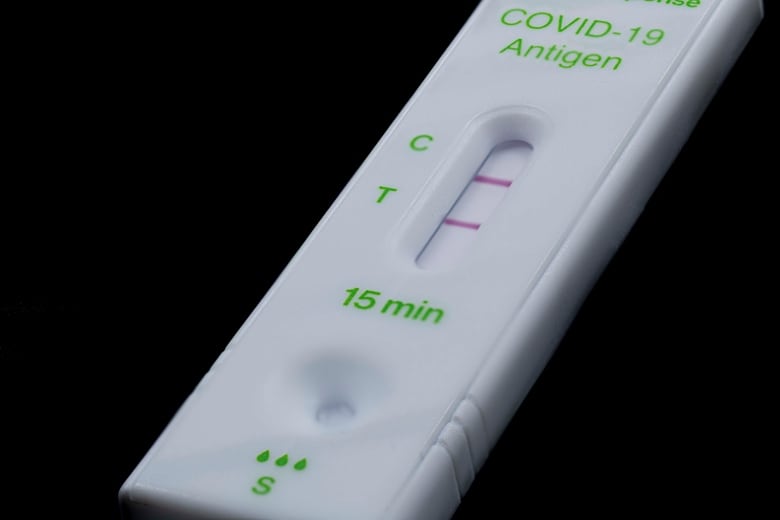What to know about EG.5, the latest Omicron subvariant in Canada

A new coronavirus subvariant on the rise in some parts of the world has also been circulating in Canada since at least May, according to the Public Health Agency of Canada.
While experts say this latest strain, EG.5, appears to be more infectious and able to sneak past our immune defences, there’s also not much evidence to suggest that it causes more severe illness.
“It’s something to certainly keep a close eye on, but I’m not significantly worried about it at this point,” said Dr. Syra Madad, an epidemiologist at the Harvard Belfer Center.
EG.5 subvariants are predicted to have made up 36 per cent of cases in Canada between July 30 to Aug. 5, according to an email the Public Health Agency of Canada (PHAC) shared with CBC News.
The agency also said it is aware of EG.5 being found 36 times in municipal wastewater between May 15 to July 21.
Last month, EG.5 was listed as a variant under monitoring by the World Health Organization (WHO) — though it is not considered a variant of concern or interest at this time.
Modelling data from the U.S. estimates that it has made up 17.3 per cent of all cases in the country over the last two weeks, making it the most common strain.
Currently, some parts of Canada are seeing a slight increase in COVID-19 cases, according to recent data.
Earlier this summer, most of the country’s wastewater had some of the lowest levels of COVID-19 since analysis began in 2020.
But as of July 27, at least seven of the 39 sites tracked by Canada’s COVID-19 wastewater surveillance dashboard have reported an increase.
In Ontario, for example, data shows that testing positivity has increased from about five per cent to nearly seven per cent within one month.
In recent weeks, the United States has also seen a jump in cases and hospitalizations.
But it’s unclear whether the new variant is driving the uptick.
What is EG.5?
EG.5, is a subvariant of Omicron — which remains the most common version of the SARS-CoV-2 virus in Canada.
Angela Rasmussen, a virologist at the University of Saskatchewan’s Vaccine and Infectious Disease Organization, says Omicron is like the “great grandparents” of all the subvariants that have followed.
“They are all essentially Omicron — you can think of it as like a family and they’re the children, grandchildren, great-grandchildren in this family,” she said.

Dr. Caroline Colijn, a mathematician and epidemiologist at Simon Fraser University, told CBC News in an email that EG.5’s mutations likely make it more infectious than the previous Omicron XBB subvariants.
Colijn, a member of an interdisciplinary team of researchers called the Coronavirus Variants Rapid Response Network (CoVaRR-Net), suspects that there could be a rise in EG.5 in the fall, but she doesn’t anticipate a “huge fall wave.”
She says that because there’s still a lot of immunity, EG.5 is not suspected to be more severe than other subvariants.
Right now, it’s unclear whether the subvariant causes any unfamiliar symptoms that haven’t already been documented by other Omicron offshoots.
“It doesn’t seem as if it’s causing, you know, an increase in severity of illness or … impacting the current vaccines and therapeutics,” said Madad, who is also the senior director of the system-wide special pathogens program at New York City Health and Hospitals.
What’s the spread like in Canada?
According to the email from PHAC, EG.5 subvariants have been found across the country, though the agency didn’t specify where.
PHAC says its scientists are “actively monitoring and evaluating EG.5 lineages,” and that they are “looking for signs that EG.5 lineages would change disease severity or spread, or impact the effectiveness of diagnostic tests, vaccines or treatments for COVID-19.”

Monitoring by CoVaRR-Net, has found that the subvariant is in Canada and it’s becoming eight per cent more frequent every day, according to Colijn.
The United States, Europe and Asia have also found EG.5 in their surveillance.
According to WHO, the earliest documented samples of EG.5 showed up in the United States in February.
When should you get a booster?
Last month, the National Advisory Committee on Immunization (NACI) said that the next round of vaccine boosters will likely be monovalent — meaning they will specifically target the Omicron family of sub-lineages.
In particular, they will target Omicron’s XBB subvariants. EG.5 is an offshoot of those.
Since EG.5 is an Omicron descendant, Dr. Prabhat Jha, a scientist at Unity Health Toronto, says the boosters coming out this fall should also work to protect against this new subvariant.
“I’m reasonably confident that we’re not looking at a new, new variant that is so different that the vaccines wouldn’t provide protection against that,” said Jha.
Even if the vaccine coming out isn’t a specific match for EG.5, Rasmussen says there’s enough data showing that variant specific boosters can have a broad effect.

While she said it won’t “completely prevent infection,” she noted that it still “provides really strong protection against hospitalization, death and some studies are suggesting long COVID as well.”
For people most at risk — those who are elderly, immunocompromised or have a chronic health issue — Jha says it’s best to speak with your family doctor about whether you should get the booster that is currently available or wait to get the fall one.
But in general, experts like Jha and Rasmussen say that to protect themselves, Canadians should:
- Mask in crowded indoor places.
- Get the latest booster vaccine, especially if they are at high risk.
- Take an at-home test to know when to stay home.
“I think we know how to live with this virus, but living with the virus means not indifference, but prudence,” said Jha. “And making sure that we use all the tools that we have.”




